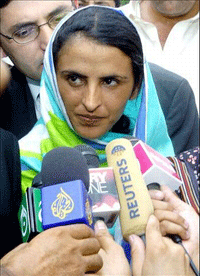
Mukhtaran Mai
Why hedonistic polygyny is against Islam
by A. Faizur Rahman
The marriage, under pressure, of Mukhtaran Mai, the courageous woman who stood up to the atavistic tribal laws of Pakistan after being honour-raped by a gang of human beasts, has brought into focus the enormity of the gender bias prevailing in Muslim societies, particularly through the misuse of the law of polygyny. Without doubt, Ms. Mai is a victim of both emotional and physical blackmail. That she is also a victim of medieval indoctrination can be deduced from her unqualified statement (“A controversial marriage in Pakistan,†The  Hindu, March 30, 2009) that taking a second wife is permitted in Islam. Therefore, it could be said with some conviction that it was the belief that her marriage was not un-Islamic (rather than the fear of jeopardising the marriages of three other women) that prompted her into marrying an already married man. For it is unbelievable that a woman of the mental strength of Ms. Mai could have succumbed to the threats of a cowardly blackmailer.
Polygyny, which finds mention just once (4:3) in the Quran, is one of the most misunderstood concepts of Islamic law. It has been abused over the centuries by Muslim men without appreciating the spirit behind its exceptional sanction, which is clearly contextualised in the historical conditions of the time when a large number of women were widowed and children orphaned as Muslims suffered heavy casualties in defending the nascent Islamic community in Medina. Even a simple reading of verses 4: 2, 3 and 127 will show that it was under such circumstances that the Quran allowed conditional polygyny, mainly to protect orphans and their mothers from an exploitative society.
Verse 4:2 warns caretakers against devouring the assets of orphans either by merging them with their own, or substituting their “worthless properties for the good ones†of the orphans. And, if the caretakers “fear that they may not be able to do justice†to the interests of the orphans in isolation, the next verse allows them to marry their widowed mothers — on the condition that the new family would be dealt justly on a par with the existing one. For those who are not up to it, the instruction of Quran was: “Then [marry] only one.â€
The sanctity of taking care of widows and their children was further emphasised in 4:127; “And remember what has been rehearsed unto you in the Book [in 4:2 and 3] concerning the orphans of women to whom you give not what is prescribed, and yet whom you desire to marry…†It is clear from these arguments that verse 4:3 is not a hedonistic licence to marry several women.
This can be better understood by analysing the concept of marriage in the Quran. Not enough research has been done on the statements of the Quran which repeatedly describe man and woman as “spousal mates†created to find “quiet of mind†(7:189) and “to dwell in tranquility†(30:21) in the companionship of each other. Verse 7:189, which traces the origin of man to a single cell (nafsan waahida), talks of the wife in the singular as zaujaha, thereby emphasising monogamy. Thus, marriage according to the Quran is the emotional bonding of two minds. This cannot be achieved simultaneously with more than one woman.
Chennai-based psychiatrist Dr. Vijay Nagaswami, in his book The 24 x 7 Marriage, echoes similar sentiments when he defines the purpose of marriage as “emotional fulfilment†of the needs of two people, which is not possible if a third person is involved.
It is sad that Muslim women have allowed themselves to be subliminally brainwashed into becoming objects of sexual gratification for men, which has resulted in scores of them suffering in silence. It is time they broke free from the shackles that hold them hostage to the whims of a few patriarchal ulema who have stalled the progress of the Muslim community through their misinterpretation of Islam. Let them take the first step towards achieving this by questioning all medieval readings of Islam that seek to exploit their femininity.
The author is a student of comparative study of religions. He may be reached at faizz@rocketmail.com.